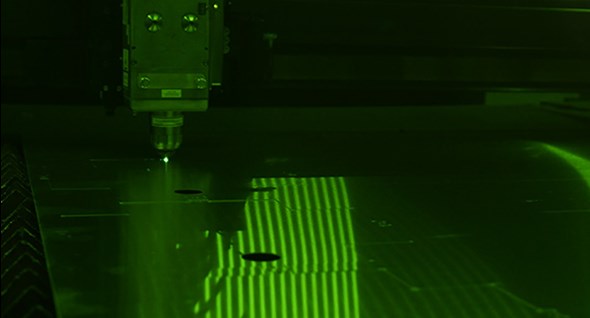Understand Your Sheet Metal Manufacturing Options
Sheet metal technology really got rolling centuries ago, and it hasn't stopped evolving. Here's a look at what you need to know today.

Sheet metal design means you have to understand the materials and machinery as well as the capabilities of the outfit doing the work. Shown here is an example of a laser cutter burning away sheet metal to produce a finished edge. Image courtesy of Proto Labs Inc
Latest News
January 14, 2019
Dear DE Reader:
Makers and designers have worked with sheet metal for centuries now, so you'd think everyone has it down cold. But CAD and analysis software, automated machinery as well as modern materials and machinery ensure that there's always something new to learn. The online paper “Designing for Sheet Metal Fabrication” will help you understand your choices.
Self-described as an exploration, this concise paper tightly of “whats” and “hows.” The net effect is that this is one “wow” of a paper.
So, why use sheet metal? Well, there's application versatility from kitchen sinks to airplanes components to beer cans. It also offers generally lower material costs compared to additive and subtractive manufacturing. An equally notable benefit is its high scalability and rapidly declining per unit costs when producing volume parts.
This paper hits stride when discussing fabrication technologies and techniques, materials, design considerations and finishes. The first discussion, the look at the materials and the finishes section leverage a quick snapshot approach rather than diving into arcane technical details.
For example, it covers cutting machinery like punch pressing, laser cutting and others by highlighting each one's unique capabilities. As well, techniques for bending and hemming shapes are explained in terms of what they do best. All sorts of sheet metals and metal alloys are available—aluminum, brass, copper and various steels. They're detailed for those without an advanced degree in metallurgy.
This formula works well. It imparts just enough clarity to strengthen your decision-making process.
The look at design considerations is more hands-on. Like any other fabrication process, you have to account for its way of doing things and lots of variables. Key here is knowing your part’s features and functions well, then closely working with a shop that knows what it's doing.
“Designing for Sheet Metal Fabrication” is well-illustrated and easy to read. It's simply good stuff. Hit today's link and see for yourself.
Thanks, Pal. – Lockwood
Anthony J. Lockwood
Editor at Large, DE
Subscribe to our FREE magazine, FREE email newsletters or both!
Latest News
About the Author
Anthony J. Lockwood is Digital Engineering’s founding editor. He is now retired. Contact him via [email protected].
Follow DE





